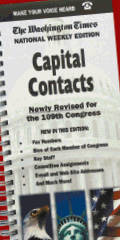
News
Behind the Headlines
Two-Cents Worth
Video of the Week
News Blurbs
Articles
Testimony
Bible Questions
Internet Articles (2009)
Internet Articles (2008)
Internet Articles (2007)
Internet Articles (2006)
Internet Articles (2005)
Internet Articles (2004)
Internet Articles (2003)
Internet Articles (2002)
Internet Articles (2001)
Free Christian Books
www.freechristianbooks.us
Free Natural Health Resources
www.healthreasources.biz
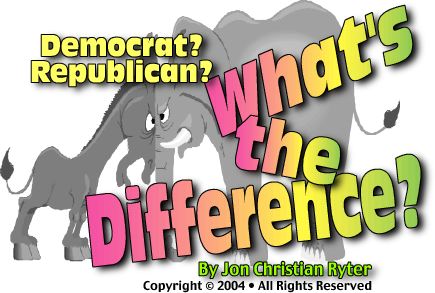
 ost
Americans have already decided which presidential contender—if
any—is going to get their vote this November. From the political
chatter on the Internet it appears that the ideologue protest vote—on
both sides of the political spectrum—will capture as much as 12%
of the vote. And it is very likely that the "no vote" at the
top of the ticket may reach a national all-time high of about 4% (instead
of the average national non-vote rate of 2%) as the American electorate
casts its ballots for national senatorial and congressional candidates,
and for state, county and local officials—by voting none-of-the-above for the office of President. of the United States. In 2000 the national none-
ost
Americans have already decided which presidential contender—if
any—is going to get their vote this November. From the political
chatter on the Internet it appears that the ideologue protest vote—on
both sides of the political spectrum—will capture as much as 12%
of the vote. And it is very likely that the "no vote" at the
top of the ticket may reach a national all-time high of about 4% (instead
of the average national non-vote rate of 2%) as the American electorate
casts its ballots for national senatorial and congressional candidates,
and for state, county and local officials—by voting none-of-the-above for the office of President. of the United States. In 2000 the national none- of-the-above vote for president was about 2.5%. In the State of Florida, where the Gore Campaign tried to count the non-votes as malfunctioned Gore votes and steal the Election of 2000, the none-of-the-above vote
at the top of the ticket was just a hair under 2%.
of-the-above vote for president was about 2.5%. In the State of Florida, where the Gore Campaign tried to count the non-votes as malfunctioned Gore votes and steal the Election of 2000, the none-of-the-above vote
at the top of the ticket was just a hair under 2%.
The primary party presidential
candidates—Sen. John Forbes Kerry and U.S. President George
W. Bush have an identity crisis. Other than the fact that one is
a tall, lanky liberal (posing as a moderate) from Massachusetts and
the other is a tall, lanky moderate (posing as a conservative) from
Texas, there isn't a whole lot of discernible difference between them
in the minds of the already decided voters.  To
the conspiracy right, both of the primary party candidates are members
of the secret Yale fraternal society of Skull & Bones that,
like the Cecil Rhodes' Circle of the Initiates (more commonly
known as The Society or The Group), is comprised of the
wealthy sons of the wealthy scions who were born and bred to become
the world's leaders and heads of State—and the almost completely
invisible barons of banking and industry who sit upon the very pinnacle
of the world. What makes Skull & Bones, like The Society,
so ominous to the conspiracy buffs is that everything they do is secretive.
The Bilderbergers are also secretive since they do not allow
the media to attend their
To
the conspiracy right, both of the primary party candidates are members
of the secret Yale fraternal society of Skull & Bones that,
like the Cecil Rhodes' Circle of the Initiates (more commonly
known as The Society or The Group), is comprised of the
wealthy sons of the wealthy scions who were born and bred to become
the world's leaders and heads of State—and the almost completely
invisible barons of banking and industry who sit upon the very pinnacle
of the world. What makes Skull & Bones, like The Society,
so ominous to the conspiracy buffs is that everything they do is secretive.
The Bilderbergers are also secretive since they do not allow
the media to attend their 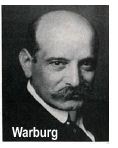 meetings.
But, so is the Federal Reserve. Our central banking system is
so secretive that when its first Fed Chairman, Paul Warburg,
was appointed he refused to appear as his own confirmation hearing before
the Senate Banking Committee. He told Congress that his appearance
might impede his ability to function as the head of the Fed. The Senate
hastily confirmed him without a hearing. Now, that's secret!
meetings.
But, so is the Federal Reserve. Our central banking system is
so secretive that when its first Fed Chairman, Paul Warburg,
was appointed he refused to appear as his own confirmation hearing before
the Senate Banking Committee. He told Congress that his appearance
might impede his ability to function as the head of the Fed. The Senate
hastily confirmed him without a hearing. Now, that's secret!
And just as an aside, Warburg became the "model" for the Daddy Warbucks character in Joseph Tipton's Little Orphan Annie. It is important to remember that America's elite families don't belong to secret societies like Skull & Bones and The Society because they are up to something sinister—even though they might very well be up to something sinister. Because of their vast wealth and/or blueblood status, they are taught from childhood that they were born to rule. The secret societies to which they belong are fraternities of an elite ruling class in a nation that we've always been taught is a classless society where all men are created equal. It is just that some members of our society are, perhaps, just a little more equal than the rest of us. With wealth comes privilege—and power. The wealth of the wealthiest of these scions dwarfs the wealth of those we are led to believe—like Bill Gates—are the richest men in the world. Unlike people like Bill Gates or the Walton family that owns Wal-Mart, these families are so rich that there is no instrument by which their wealth can be measured. That 's largely the secret they are hiding. While the Kerrys and the Bushes are not among the wealthiest Americans, both families qualify for membership in that elite privileged group, thus their indoctrination into fraternities like Skull & Bones.
Hardcore conservatives view Bush as a neo-conservative due to the passage of the USA Patriot Act. In the hands of the wrong president, the Patriot Act could, and likely will, be used as a political devise to stifle what remains of free speech and constitutionally-protected protest in America. Of all of the things George W. Bush did during his first term that will cost him votes, this was probably his biggest tactical blunder.
Kerry, who is a socialist practitioner of moral relativism, is posing as a middle-of-the-road moderate because he knows that the American people hate liberal ideologues—especially ones as far to the left as him. But Kerry isn't fooling anyone except perhaps the welfare crowd who really doesn't care anyway. They know if Kerry gets elected, he will become their personal Robin Hood, stealing from the pockets of the middle class to support the "victims" of moral relativism who believe the middle class "haves" are morally obligated to financially support the have nots. So the fact that Kerry has a political agenda that is antithetical to the historic Christian-conservative interests of the American people means nothing to them.
The conservatives also know
that while serving in the Mekong Delta for four months, Lt.
jg John F. Kerry manipulated the system by having his own men recommend
him for undeserved and unearned medals and commendations that he could
use to further his political ambitions.  Kerry even went so far as to bring a movie camera with him to Vietnam to record
his military exploits so he could use them in his political campaigns
as he sought high office in the United States.
Kerry even went so far as to bring a movie camera with him to Vietnam to record
his military exploits so he could use them in his political campaigns
as he sought high office in the United States.
Conservatives, many of whom served in Vietnam or in other military actions, were equally unimpressed with Bush's safe berth in the Texas Air National Guard during the Vietnam War. That may be due in part to the fact that they are unaware that 2nd Lt. George W. Bush did everything he could to be transferred to fighter pilot duty in Vietnam. Powerful forces—perhaps in the form of his mother goading his father to use his influence to make sure her son remained out of harm's way—kept Bush stateside as his requests for transfer to Vietnam were never acted upon. But, they were initiated by Bush. In one instance Lt. Bush was told the military was using different fighter planes in Vietnam and that he couldn't go because he wasn't qualified to fly them.
The major political parties in the United States have become institutionalized over the past eight decades with the power to govern increasingly shared by the illegal bureaucracy that was created by Franklin Roosevelt and the special interest groups that, since 1920, have financed the successful politicians who won the seats in Congress and determined the political agenda that would be enacted. The transfer of power from the people occurred when the wealthy American utopians wrenched control of the political process from the people shortly after World War I using money, influence, and their control of the media to accomplish their objective. From that perspective, there is now little difference between a Democrat or a Republican.
Today, both major parties represent those special interests first and the people second. It is only during an election year when votes count more than dollars that politicians remember the electorate with exaggerated solicitude as they promise the voters solutions to all of society's ills through the largesse of Uncle Sam—with the taxpayer's own money. Congress consistently over-promises, overspends and overtaxes the American people.
For that reason alone it is
no wonder that small factions of Americans rose up and formed alternative
political parties in an enervated attempt to have their voices heard
beyond the office water cooler or the Internet. And, its no wonder that
those Americans dogmatically defend those alternative party candidates
with a wistful although forlorn hope that their candidate would somehow
get elected. Liberal ideologues, on the other hand, are never deluded
into believing their long shot candidates will overwhelm the primary
party candidates. It won't happen and they know it. What they will accomplish,
if not this election, then the next, is to force the Democrats to hammer
their issues into planks on the Democratic platform.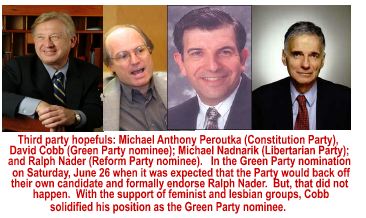 The conservatives, for some reason, aren't that smart. They continue
to believe that their alternative party candidate can actually win.
The conservatives, for some reason, aren't that smart. They continue
to believe that their alternative party candidate can actually win.
Alternative party candidates have always been a troublesome problem for the power brokers behind the seats of government because early in our history the bankers and the industrialists couldn't stop popular candidates like Andrew Jackson from getting elected. By 1912 the money barons had mastered the art of harnessing third party candidates. From that point forward in American history, third party candidates have been adroitly used by the power barons to guarantee that the major party candidate they were backing received enough electoral votes to secure the White House. That is generally accomplished today by granting or denying all of the other third party candidates space in the media or at the podium during the presidential debates.
Much to his dismay during
the Election of 2000, Reform Party presidential nominee Pat Buchanan became the invisible candidate the moment he won
the Reform Party's nomination for President in what was later
called a "split ballot." Even though the headlines in most
of the major newspapers 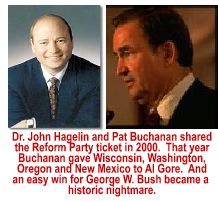 announced
that Buchanan had won, it was John Hagelin's photo, not Buchanan's that graced the front pages of those newspapers. And
the articles which mentioned Buchanan's win in the headline were
actually articles how the Reform Party under John Hagelin refused to be hijacked by a right wing ideologue
by leaving Buchanan's convention and going to another hotel down
the street where they nominated Hagelin.
announced
that Buchanan had won, it was John Hagelin's photo, not Buchanan's that graced the front pages of those newspapers. And
the articles which mentioned Buchanan's win in the headline were
actually articles how the Reform Party under John Hagelin refused to be hijacked by a right wing ideologue
by leaving Buchanan's convention and going to another hotel down
the street where they nominated Hagelin.
At the same time in 2000, Hagelin was also the presidential candidate of the Naturalist
Party. When the election was over, Hagelin disbanded the Naturalist Party and set up what he termed a "complementary"
government called the US Peace Government. Its purpose, Hagelin says was "...to prevent social violence, terrorism and war;
and to promote harmony and peace." Nader's candidacy
in 2000 instilled a breath of life in the Green Party. There
are now 300 thousand registered Green Party voters. There are Green Party candidates running in 44 States. Matt Gonzales won 47% of the vote in the San Francisco mayoral race and Green Party candidate Jason West won the mayor's race in New Paltz, New York.
Even though life was infused into the Green Party by Reform
Party nominee Ralph Nader in 2000, the Green Party rejected the idea of endorsing him in favor of 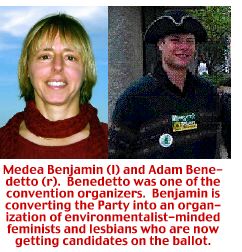 David
Cobb largely because of the feminist and lesbian participation in
the Green Party this year. Heavily involved in blocking Nader was feminist Medea Benjamin who founded United for Peace &
Justice; Code Pink, Women for Justice; and Global Exchange.
Prior to 2004, your typical Green Party supporter was a white,
greying heterosexual middle-class, causally-dressed baby-boomer who
was more concerned about smog than world trade or global governance.
Since 2000 the Green Party has been overhauled. Through the efforts
of Benjamin and a coterie of feminists, homosexuals, lesbians
and young recent college grad environmentalist ideologues like Adam
Benedetto and Tim Condon (who shaves his head and wears collarless
black suits). Benedetto and Condon "packaged"
this year's Green Party convention to reach a younger and more
diverse crowd. "We just want to change what you think a Green
Party person ought to be," Condon told the media. "Us
young people, we're from the packaging generation where if it doesn't
look good it can't be taken seriously." And, change the party
they did. While the potbellied baby boomers were evident everywhere
at the convention center in Milwaukee, so were the hippies, the feminists,
the lesbians, homosexuals and the young environmentalist protest activists.
David
Cobb largely because of the feminist and lesbian participation in
the Green Party this year. Heavily involved in blocking Nader was feminist Medea Benjamin who founded United for Peace &
Justice; Code Pink, Women for Justice; and Global Exchange.
Prior to 2004, your typical Green Party supporter was a white,
greying heterosexual middle-class, causally-dressed baby-boomer who
was more concerned about smog than world trade or global governance.
Since 2000 the Green Party has been overhauled. Through the efforts
of Benjamin and a coterie of feminists, homosexuals, lesbians
and young recent college grad environmentalist ideologues like Adam
Benedetto and Tim Condon (who shaves his head and wears collarless
black suits). Benedetto and Condon "packaged"
this year's Green Party convention to reach a younger and more
diverse crowd. "We just want to change what you think a Green
Party person ought to be," Condon told the media. "Us
young people, we're from the packaging generation where if it doesn't
look good it can't be taken seriously." And, change the party
they did. While the potbellied baby boomers were evident everywhere
at the convention center in Milwaukee, so were the hippies, the feminists,
the lesbians, homosexuals and the young environmentalist protest activists.
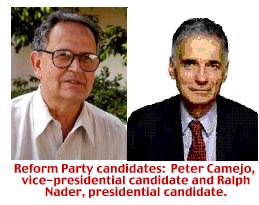 Ralph
Nader, who is the Reform Party nominee, chose not to go to
the Green convention Milwaukee, opting instead to send his running
mate, Peter Camejo, who is a Green Party activist, to
represent them. But the Greens took his "no-show" as
a snub. Benjamin campaigned hard for David Cobb who describes
himself as a "male feminist." Cobb, like Benjamin has no illusions about winning the election and, in fact, tells Green
Party loyalists to vote for Kerry in the swing States but
to vote for him in the States that Bush and Kerry have
locked up. Although Nader is viewed by most rank-and-file Green
Party members who think they are actually voting for someone who
can win the presidency, the hierarchy of the Green Party has
no illusions. They know their candidate—at the national level—can't
win. He's on the ticket to support the local, county and State candidates
who can win. Moreover, he's on the national ticket only to force the
Democrats to adopt their positions on diversity rights and environmentalism
to guarantee Green Party support for Kerry on election
day in November. There are no illusions in the party hierarchy even
though in their campaign speeches they act like they are backing a winner.
The young activists within the Green Party blame Nader—the Green Party's candidate in 2000—for Al Gore's loss
that year since he won well over a thousand votes in Florida
that year—more than enough to have placed Al Gore in the
White House on the morning of Nov. 8, 2000.
Ralph
Nader, who is the Reform Party nominee, chose not to go to
the Green convention Milwaukee, opting instead to send his running
mate, Peter Camejo, who is a Green Party activist, to
represent them. But the Greens took his "no-show" as
a snub. Benjamin campaigned hard for David Cobb who describes
himself as a "male feminist." Cobb, like Benjamin has no illusions about winning the election and, in fact, tells Green
Party loyalists to vote for Kerry in the swing States but
to vote for him in the States that Bush and Kerry have
locked up. Although Nader is viewed by most rank-and-file Green
Party members who think they are actually voting for someone who
can win the presidency, the hierarchy of the Green Party has
no illusions. They know their candidate—at the national level—can't
win. He's on the ticket to support the local, county and State candidates
who can win. Moreover, he's on the national ticket only to force the
Democrats to adopt their positions on diversity rights and environmentalism
to guarantee Green Party support for Kerry on election
day in November. There are no illusions in the party hierarchy even
though in their campaign speeches they act like they are backing a winner.
The young activists within the Green Party blame Nader—the Green Party's candidate in 2000—for Al Gore's loss
that year since he won well over a thousand votes in Florida
that year—more than enough to have placed Al Gore in the
White House on the morning of Nov. 8, 2000.
On the other side of the political
spectrum we have the conservative Constitution Party whose adherents
misguidedly believe their candidate, Michael Anthony Peroutka can somehow magically win enough popular votes to actually win the electoral
votes needed to topple both major party candidates. Their ardor is based
solely on Christian faith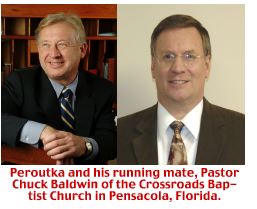 and the hope that God will provide a miracle because the principles
upon which the Constitution Party's campaign is based are Godly.
In the secular world of national politics, that is not sound political
reality. If enough Christians vote for Peroutka, they may succeed
in doing to Bush what Nader did to Gore—put
the opposition candidate in the White House. For those who steadfastly
believe that a miracle will happen and Peroutka can get elected,
let me make a simple observation to show you the sheer impossibility
of the Constitution Party myth. Roughly 42% of the electorate
are moderate to hardcore liberals. They would vote for Antichrist if
he topped the Democratic ticket. They will vote for John Kerry even if Hillary Clinton somehow ends up as his running mate.
Forty percent of the voters are equally dedicated Republicans. Most
are Christians. They will vote straight partyline unless Bush commits
some mortal error between now and November. That leaves 18% of the electorate.
They are swing voters. About half of them identify themselves as Christians,
although many of them sit in the pews of liberal denominational churches
on those Sundays they choose to attend church. It is this constituency
that both the Democrats and Republicans are chasing, and with whom each
is attempting to identify. These voters are largely pro-gun rights union
members. They tend to be social moderates and fiscal conservatives.
And while they are believe in moral relativism—they have a "live
and let live" mentality —they are largely pro-family heterosexuals
who believe abortion is okay "sometimes." Sometimes, of course,
means when one of their unmarried teenage daughters gets pregnant. In
those close elections where the two major party candidates look like
blood brothers, that vote splits down the middle and it is then that
the third party candidates decide who is going to occupy the White House. Of course, it will never be the third party candidate, and all of
them know it. They are in the race for the matching funds and the
scrapbook full of memories when the race is over. So, let's assume for
a minute that somehow the Peroutka Campaign caught on fire and Peroutka and Baldwin somehow magically took half of the Bush vote, and half of the undecided vote. While that is "whistling
up a tree" wishful thinking that won't happen since Peroutka will take only 1% to 2% of the vote, let's assume for a moment that
in fantasyland, it did. Then, at best, Peroutka would net 24.5%
of the vote since the liberal voters will not cast a single vote for
a man who has pledged to end abortion in January, 2005. Taking that
scenario to its obvious conclusion, that would mean that Bush would also take 24.5% of the vote and John Kerry would be elected
with an electoral vote landslide with around 46% to 47% of the popular
vote (since Nader will take 3% to 4%). Then the opposite of what Peroutka is promising would happen. On January 20, 2005, John
Kerry's first official act as President would be to revoke all of Bush's anti-abortion Executive Orders
and free up federal money to fund abortions for welfare moms. His second
official act would likely be to end all Bush Administration family
values initiatives—including any chances of outlawing homsexual
and lesbian marriages in the United States.
and the hope that God will provide a miracle because the principles
upon which the Constitution Party's campaign is based are Godly.
In the secular world of national politics, that is not sound political
reality. If enough Christians vote for Peroutka, they may succeed
in doing to Bush what Nader did to Gore—put
the opposition candidate in the White House. For those who steadfastly
believe that a miracle will happen and Peroutka can get elected,
let me make a simple observation to show you the sheer impossibility
of the Constitution Party myth. Roughly 42% of the electorate
are moderate to hardcore liberals. They would vote for Antichrist if
he topped the Democratic ticket. They will vote for John Kerry even if Hillary Clinton somehow ends up as his running mate.
Forty percent of the voters are equally dedicated Republicans. Most
are Christians. They will vote straight partyline unless Bush commits
some mortal error between now and November. That leaves 18% of the electorate.
They are swing voters. About half of them identify themselves as Christians,
although many of them sit in the pews of liberal denominational churches
on those Sundays they choose to attend church. It is this constituency
that both the Democrats and Republicans are chasing, and with whom each
is attempting to identify. These voters are largely pro-gun rights union
members. They tend to be social moderates and fiscal conservatives.
And while they are believe in moral relativism—they have a "live
and let live" mentality —they are largely pro-family heterosexuals
who believe abortion is okay "sometimes." Sometimes, of course,
means when one of their unmarried teenage daughters gets pregnant. In
those close elections where the two major party candidates look like
blood brothers, that vote splits down the middle and it is then that
the third party candidates decide who is going to occupy the White House. Of course, it will never be the third party candidate, and all of
them know it. They are in the race for the matching funds and the
scrapbook full of memories when the race is over. So, let's assume for
a minute that somehow the Peroutka Campaign caught on fire and Peroutka and Baldwin somehow magically took half of the Bush vote, and half of the undecided vote. While that is "whistling
up a tree" wishful thinking that won't happen since Peroutka will take only 1% to 2% of the vote, let's assume for a moment that
in fantasyland, it did. Then, at best, Peroutka would net 24.5%
of the vote since the liberal voters will not cast a single vote for
a man who has pledged to end abortion in January, 2005. Taking that
scenario to its obvious conclusion, that would mean that Bush would also take 24.5% of the vote and John Kerry would be elected
with an electoral vote landslide with around 46% to 47% of the popular
vote (since Nader will take 3% to 4%). Then the opposite of what Peroutka is promising would happen. On January 20, 2005, John
Kerry's first official act as President would be to revoke all of Bush's anti-abortion Executive Orders
and free up federal money to fund abortions for welfare moms. His second
official act would likely be to end all Bush Administration family
values initiatives—including any chances of outlawing homsexual
and lesbian marriages in the United States.
Thousands of born again Christians will likely rally around the Constitution Party much the same way thousands of Christians rallied around Pat Robertson's presidential candidacy in 1988. Robertson, unlike Peroutka, knew that third party candidates were nonentities. He campaigned against George H.W. Bush for the Republican nomination, and endorsed Bush when he was unable to rally traditional Republicans to support his candidacy, knowing that if he fractured the Christian conservative base he would be responsible for electing Massachusetts governor Michael Dukakis that year.
Just as Nader and Cobb and Medea Benjamin—who succeeded in converting the Green Party into a political sanctuary for moral relativism feminists—represent the unelectable liberal left, Michael Peroutka and Chuck Baldwin represent the unelectable conservative right. Extremism, whether on the right or the left, plays well only with the zealots within those fringes but can't attract a sufficient political base to actually win an election. Political zealots are generally more interested in the ideology of their political statement than they are in winning the election. Most zealots think nothing of wasting their votes on men who can't get elected; choosing instead to use their votes as political statements.
In a political statement issued on May 14, 2004, Peroutka promised his constituents an "abortion free America by January, 2005." Peroutka said, "...if elected, I promise that abortion will end my first day in office." He continued, by saying "...It is, by the way, within the power of the President to end abortion tomorrow, as I would from my first day in office..." Like most presidential candidates, Peroutka began his campaign for the White House with a promise he knows he can't keep. (And, if he doesn't know he can't keep it, he shouldn't be running for President.) Since the Constitution does not provide the President with legislative or judicial authority, he lacks the authority to overrule the United States Supreme Court by banning abortions in the United States. If a President could ban abortion rights by Executive Order, Ronald Reagan would have done that on January 20, 1981, followed by a similar decree by George W. Bush on January 20, 2001.
When President George W. Bush entered the Oval Office shortly after noon on January 20, 2001, he began the task of attempting to undo a series of Executive Orders issued by former President Bill Clinton. The first Executive Order signed by Bush removed federal funding of abortion—the most any President can legally and constitutionally do in this area. Bush then attempted to undo a series of Executive Orders signed by Clinton that implemented the provisions of the Kyoto Protocol (the UN's Global Warming Treaty) that was never ratified by Congress, as required by the Constitution of the United States before a Treaty can be acted upon by the Executive branch of government. Bush ran into a legal buzzsaw.
The Democratic leadership filed suit against the Bush Administration in federal court arguing that Bush's decision to deconstruct the programs of the Clinton Administration was merely a mean-spirited partisan political ploy that would harm the health of the American people and violate the Clean Air Act. The US District Court agreed and ruled that, in this one instance, an incoming president could not vacate the Executive Orders of a former president. What Bush was trying to do was prevent international environmental laws from being enforced by the United States Environmental Protection Agency [EPA] since he knew those laws would drive not only jobs, but employers, from the United States. Using judicial activism,a Clinton-appointed US District Court judge stopped Bush by negating his Executive Order. The jobs-drain continued at warp speed and there was nothing the Bush Administration could do about it. Thanks to a liberal judge.
Bush's actions in the opening days of his presidency, and the Democratic response to those actions, more than anything, explain the stark differences between the Republican and Democratic Parties for those Americans who believe that because the political parties have become institutionalized over the years, and because powerful special interests control much of what happens inside the beltway, that there is no longer any difference between Republicans and Democrats—or more appropriately—between the right and the left, between conservatives and liberals, or even more accurately, between free market republicans and state-controlled economy socialists. Nothing could be farther from the truth. America is losing its national identity because the people failed, since 1932, to recognize the subtle ideological differences between the right and the left when the candidates seeking the highest office of the land appear to be blood brothers.
The culture war that the Democrats
could not win in Congress has now evolved into a class and culture war
that is now being waged quite successfully in the federal courtrooms
of liberal judicial activist judges thanks to deconstructionist members
of the US Senate who very deliberately place judicial activists on the
federal bench. The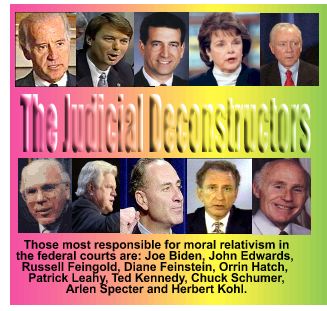 culture war radicals of the 1960s— people like Bill and Hillary Clinton, John Kerry, Nobel laureate Toni Morrison,
former Congresswoman Pat Schroder, former Congress-man Ron
Dellums, Julian Bond, the former mayor of Atlanta and NAACP leader, and a host of other liberal culture war activists—who became
national leaders or recognized national spokespeople for their culture
classes in the 1980s and 1990s, contributed much to devolution of traditional
values in America. But they could not have succeeded without several
current deconstructionist members of the US Senate who sit on the Judiciary
Committee (which determines the appointment of all federal judges—and
the ideological slant of their decisions as they exercise their self-delegated
right of judicial review). They are: Joseph Biden [D-DE], John
Edwards [D-NC], Russell Feingold [D-Wi], Dianne Feinstein [D-CA], Orrin Hatch [R-UT], Teddy Kennedy [D-MA], Herbert
Kohl [D-WI], Patrick Leahy [D-VT], Charles Schumer [D-NY], and Arlen Specter [R-PA]. Two of the cultural deconstructionists
are Republicans—Hatch and Specter.
culture war radicals of the 1960s— people like Bill and Hillary Clinton, John Kerry, Nobel laureate Toni Morrison,
former Congresswoman Pat Schroder, former Congress-man Ron
Dellums, Julian Bond, the former mayor of Atlanta and NAACP leader, and a host of other liberal culture war activists—who became
national leaders or recognized national spokespeople for their culture
classes in the 1980s and 1990s, contributed much to devolution of traditional
values in America. But they could not have succeeded without several
current deconstructionist members of the US Senate who sit on the Judiciary
Committee (which determines the appointment of all federal judges—and
the ideological slant of their decisions as they exercise their self-delegated
right of judicial review). They are: Joseph Biden [D-DE], John
Edwards [D-NC], Russell Feingold [D-Wi], Dianne Feinstein [D-CA], Orrin Hatch [R-UT], Teddy Kennedy [D-MA], Herbert
Kohl [D-WI], Patrick Leahy [D-VT], Charles Schumer [D-NY], and Arlen Specter [R-PA]. Two of the cultural deconstructionists
are Republicans—Hatch and Specter.
Even with the GOP in control of the US Senate, there is not much chance of any Republican president's conservative judicial nominations getting a fair hearing—or a confirmation vote. Since committee membership is based on the ratio of seats held in the chamber, the only way this can change is for the American people to elect more Republicans—not simply conservatives, but conservative Republicans—to the US Senate since the two major parties control all "seating arrangements" on the various committees. The Judiciary Committee is one of the two or three most powerful committees in the US Senate since all federal judges must be approved by that committee before they become a permanent addition to the federal bench. Federal judges who are "seated" by recess appointments serve only until the next session of Congress. If they make the mistake of becoming activist judges with a judicial philosophy in opposition to the majority party, their nominations never see the light of day. Only another recess appointment will keep them on the bench until that president's term in office ends. But, in the interim, these temporary judges can do a lot of damage to the Constitution and the rule of law.
The invisible use of judicial activism to rewrite, or unconstitutionally "legislate" laws that could never be successfully enacted by Congress have changed the very concepts of the rule of law in the United States by allowing judges to unconstitutionally legislate social reform from the bench. When you are looking for the differences between the Democrats and Republicans, you need look no farther than the abrogation of the rule of law by liberal federal judges. You will see what I mean when we look at two watershed issues that found themselves before the US Supreme Court. In the first instance activist judges legislating from the bench created a new law that outlawed an inherent right—freedom of religion—that is not only guaranteed by the 1st Amendment, but the Constitution states that Congress (the lawmaking body) cannot write any law that in any way abridges or obstructs the rights of the people to practice their religion—anywhere and at anytime. Of course, you could say that Congress didn't—the Supreme Court which is supposed to protect the sanctity of the Constitution—did. However, adjudicating a law is no different than penning one. In the second example the justices, again legislating from the bench, created a new law that granted women a new right. The right to kill their unborn children. In this case, the justices simply created a right that did not exist. They have spend 31 years trying to find a home clause to bind that right to the Constitution since none exists. That's why Chief Judge Richard N. Posner of the US Court of Appeals for the 7th Circuit calls the 1973 Roe v Wade decision the "Wandering Jew of Constitutional Law"—because the right to kill your unborn child does not exist anywhere in the Constitution. It was a law the globalists needed passed because the brain trust in the Rockefeller Foundation was convinced that, by the year 2000, the world would be so overpopulated that half its population would be starving and the means to radically curb the perceived population explosion had to be legislated.
It was not legislators but judges that decided, in 1947 in Everson v Board of Education (330 US 1, 18) that "...The 1st Amendment has a created a wall of separation between church and state. That wall must be kept and impregnable. We could not approve the slightest breech." (The first mention of that wall of separation occurred in 1878 in Reynolds v United States [98 US 145, 164] when the high court rewrote the 1st Amendment through legal interpretation. They upheld that decision in Pierce v Society Sisters in 1925. In Everson 22 years later the justices entwined the fate of the States in their decision by coupling the 14th Amendment into their distorted view of the 1st Amendment.
The following year, in 1948,
an atheist, Vashti McCollum, a Champlain, Illinois housewife
argued that an Illinois state law that allowed students to be excused
from school one afternoon each week to attend Bible classes—with
the consent of their parents—for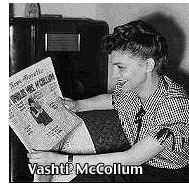 voluntary religious instructions at their own local churches discriminated
against her son, Jim. McCollum asked that the law be struck and
that the State be forbidden to allow any child to be taught that there
is a deity called God. (It is important to note that McCollum's
son was not forced to go to any church for instruction since his mother—who
was raised in a devout Christian home herself—was an atheist.
voluntary religious instructions at their own local churches discriminated
against her son, Jim. McCollum asked that the law be struck and
that the State be forbidden to allow any child to be taught that there
is a deity called God. (It is important to note that McCollum's
son was not forced to go to any church for instruction since his mother—who
was raised in a devout Christian home herself—was an atheist.  He
was allowed to remain in a study classroom with other children whose
parents did not sign off on the religious training classes.)
He
was allowed to remain in a study classroom with other children whose
parents did not sign off on the religious training classes.)
There actually was no constitutional issue at stake in McCollum v Board of Education (333 US 203). So the Supreme Court created one. The State was completely neutral in the issue. The funding came from the local churches throughout Illinois, so it cost the State nothing. Those students who wanted to attend, and whose parents allowed them to attend, were granted leave. So there was no religious instruction taking place on school property. Those who did attend the classes remained in their classroom. The State of Illinois entered the equation only because they allowed those students attending classes to be excused from school for three hours one afternoon each week.
The initial argument of the Supreme Court was that tax-supported properties (i.e., public schools) could not be used for religious instruction. (Strangely, today Muslim groups are now distributing the Koran in America's public schools and teachers are now forcing their students to read it—not as a book of religious training, which it is, but as a book that explains the cultural distinctions of Islam. And, there is no protest from the ACLU.) When the high court realized that there was no religious education happening on school property, they modified their position, arguing that the close cooperation between the school board that controlled the "tax-supported property" and the religious community violated the establishment clause. Interestingly, that year the globalists were becoming increasingly concerned that religion and patriotism were too closely linked. There was a growing consensus that as long as the American sense of national patriotism remained at such a high level, world government could never be achieved.
 On
April 6, 1946 President Harry S. Truman proposed a new public
school curriculum called Towards World Understanding that would
prepare high school students for entrance into world citizenship. A
year later, Julian Huxley, UNESCO's Director General issued
a scholastic directive entitled In the Classrooms with Children Under
13-years of Age. On the opening page of the guidebook, which was
distributed throughout the American public school system, Huxley noted: "Before the child enters school
his mind has already been profoundly marked, and often injuriously,
by earlier influences...first gained, however dimly, in the home." On page 9, he continued his attack on the family and the home: "The
kindergarten or infant school has a significant part to play in the
child's education. Not only can it correct many of the errors of home
training, but it can also prepare the child for...social identification
that he must achieve on his way to membership in the world society." On page 58, Huxley observed that "...[a]s
we have pointed out, it is frequently the family that infects the child
with extreme nationalism. The school should therefore use the means
described earlier to combat family attitudes." Among
those things that "infect" the family Huxley continued,
are [a] religion, [b] patriotism, [c] learning too much
American history, and [d] learning
too much about world geography.
On
April 6, 1946 President Harry S. Truman proposed a new public
school curriculum called Towards World Understanding that would
prepare high school students for entrance into world citizenship. A
year later, Julian Huxley, UNESCO's Director General issued
a scholastic directive entitled In the Classrooms with Children Under
13-years of Age. On the opening page of the guidebook, which was
distributed throughout the American public school system, Huxley noted: "Before the child enters school
his mind has already been profoundly marked, and often injuriously,
by earlier influences...first gained, however dimly, in the home." On page 9, he continued his attack on the family and the home: "The
kindergarten or infant school has a significant part to play in the
child's education. Not only can it correct many of the errors of home
training, but it can also prepare the child for...social identification
that he must achieve on his way to membership in the world society." On page 58, Huxley observed that "...[a]s
we have pointed out, it is frequently the family that infects the child
with extreme nationalism. The school should therefore use the means
described earlier to combat family attitudes." Among
those things that "infect" the family Huxley continued,
are [a] religion, [b] patriotism, [c] learning too much
American history, and [d] learning
too much about world geography.
The globalists, within our government and without, believed that the traditional family with strong religious values generated a type of proud patriotism that led to what Huxley described as extreme nationalism. It was believed if those tethers could be sufficiently weakened, the American people would be more receptive to world government. Thus, the "motive" for the UN to legislate a new morality in America that started with the removal of God from the school and from the lives of our children. Clearly the 1st Amendment prohibited Congress from doing with the stroke of a pen what the judicial activists succeeded in doing with the slam of a gavel. God has effectively been removed from the lives of the American people—and we can see those changes on TV, at the movies, and in the attitudes of people on the streets of our cities and towns across this nation.
When you ask: "What's the difference between Democrats and Republicans?" this is the difference. Democrats fill our courts with judges who practice moral relativism. Liberal judges, with a legal license to rewrite the laws cast by Congress through interpretation, are judicial activists who practice social justice. Judges appointed by conservative Republicans adhere to the rule of law. Quite simply, that's the difference.
The second prerogative concerned
the judicial legislating of an unbridled right to abortion in the United
States that was never, nor could ever be, enacted by .jpg) Congress.
It is a "law" that was unconstitutionally legalized by a judicial
decree of the United States Supreme Court on Jan. 22, 1973 when seven
of the nine justices voted to legalize abortion-on-demand. The most
interesting thing about Roe v Wade; Doe v Bolton is that not
even Associate Justice Harry Blackmun, who engineered the debate
and wrote the decision, knew where that "fundamental" right
existed in the Constitution. He noted on the first page his decision
that he believed the woman's right to privacy that allowed her to kill
her unborn child was found in the 14th Amendment, but it wasn't.
Judicial activists have tried to hang it on just about every amendment
in the Bill of Rights, but it fits like an extra piece in a jigsaw puzzle.
Constitutional scholars have not been able to ground Roe v Wade to any particular clause simply because it is a right that does not,
nor ever did, exist in the Constitution. Seven justices illegally and
unconstitutionally wrote law by judicial fiat—a right they do not
possess under the Constitution. Voting to create abortion rights in
American on Jan. 22, 1973 were:Chief Justice Warren Burger, who
was so weak he could not control his own court and Associate Justices Harry Blackmun, William J. Brennen, William O. Douglas, Thurgood Marshall, Lewis Powell and Potter Stewart.
Voting against Roe v Wade were Associate Justices William
H. Rehnquist and Byron White. All of the justices were appointed
and confirmed by a Democratically-controlled U.S. Senate Judiciary Committee. Nixon appointed four of the justices. Eisenhower appointed
two. Appointing one each were Roosevelt, Kennedy and Johnson.
By extension, you might be inclined to think that because Republicans
appointed six of the nine, Roe v Wade should have never became
law. While Presidents attempt to appoint justices to the high court
who reflect their own values, who a president nominates and who ultimately
gets appointed are many times two—or more, different people.
Congress.
It is a "law" that was unconstitutionally legalized by a judicial
decree of the United States Supreme Court on Jan. 22, 1973 when seven
of the nine justices voted to legalize abortion-on-demand. The most
interesting thing about Roe v Wade; Doe v Bolton is that not
even Associate Justice Harry Blackmun, who engineered the debate
and wrote the decision, knew where that "fundamental" right
existed in the Constitution. He noted on the first page his decision
that he believed the woman's right to privacy that allowed her to kill
her unborn child was found in the 14th Amendment, but it wasn't.
Judicial activists have tried to hang it on just about every amendment
in the Bill of Rights, but it fits like an extra piece in a jigsaw puzzle.
Constitutional scholars have not been able to ground Roe v Wade to any particular clause simply because it is a right that does not,
nor ever did, exist in the Constitution. Seven justices illegally and
unconstitutionally wrote law by judicial fiat—a right they do not
possess under the Constitution. Voting to create abortion rights in
American on Jan. 22, 1973 were:Chief Justice Warren Burger, who
was so weak he could not control his own court and Associate Justices Harry Blackmun, William J. Brennen, William O. Douglas, Thurgood Marshall, Lewis Powell and Potter Stewart.
Voting against Roe v Wade were Associate Justices William
H. Rehnquist and Byron White. All of the justices were appointed
and confirmed by a Democratically-controlled U.S. Senate Judiciary Committee. Nixon appointed four of the justices. Eisenhower appointed
two. Appointing one each were Roosevelt, Kennedy and Johnson.
By extension, you might be inclined to think that because Republicans
appointed six of the nine, Roe v Wade should have never became
law. While Presidents attempt to appoint justices to the high court
who reflect their own values, who a president nominates and who ultimately
gets appointed are many times two—or more, different people.
Ronald Reagan tried
hard to appoint Robert Bork, the most knowledgeable constitutional
jurist in the United States, to the high court. Because Bork was a staunch rule of law constitutionalist in an era when the globalists
needed social justice revisionists on the court, the liberals trotted
out every liberal with an axe to grind in an effort to kill Bork's
nomination. George H.W. Bush faced the same gauntlet when he
nominated Clarence Thomas to the high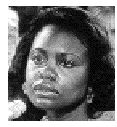 court. Thomas stayed the course when he was accused of being
the new Roe v Wade slayer. He even stayed the
court. Thomas stayed the course when he was accused of being
the new Roe v Wade slayer. He even stayed the .jpg) course
when the feminists brought out Anita Hill who accused him of
sexual harassment. Ultimately, as he was called an "Uncle Tom"
by the left, and after a forced vote by the full Senate, Thomas was confirmed.
course
when the feminists brought out Anita Hill who accused him of
sexual harassment. Ultimately, as he was called an "Uncle Tom"
by the left, and after a forced vote by the full Senate, Thomas was confirmed.
Bush-43 found the Senate Judiciary Committee—under the control of Democrats for half of his first term—to be an unyielding battleground. The only judges he got confirmed during those two years were "compromise" nominations since the conservatives he nominated never even got hearings. Those nominations have pretty much been "dead on arrival." President George W. Bush is now recycling some of his nominations that couldn't make it through the confirmation process under the Judiciary Committee when it was chaired by Senator Joe Biden. Only nominees acceptable to the liberal Democrats ever got a hearing.
The liberals aren't afraid that conservative judges will throw out Roe v Wade. Liberals are afraid that conservative high court judges will overturn moral relativism decisions, and lower court judges will not be allowed to mitigate all of the sins of the last three hundred years by meting out undeserved social justice.
So, when you ask: "What's the difference between Democrats and Republicans?" just remember—once again— here is the difference: Democrats fill our courts with judges who practice moral relativism. Liberal judges, with a legal license to rewrite the laws cast by Congress through interpretation, are judicial activists who believe that social justice trumps the rule of law. Judges appointed by conservative Republicans adhere to the rule of law. Quite simply, that's the difference. So, when you back Democrats or conservative third party candidates, you are voting to give Democrats more power to appoint more liberal judges who will rewrite our laws faster than Congress can write them. And, when Congress writes laws to curb the power of the judges, the judges will simply declare those laws unconstitutional.

Copyright © 2009 Jon Christian Ryter.
All rights reserved.
